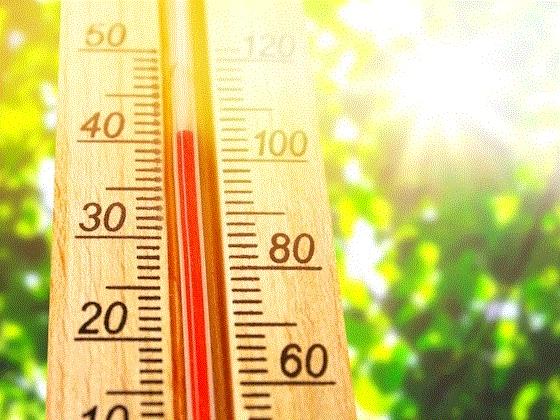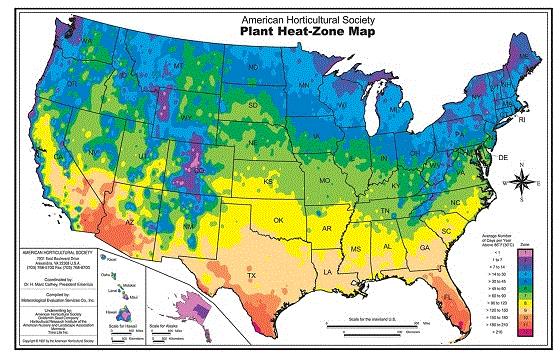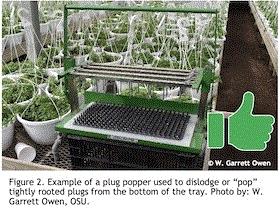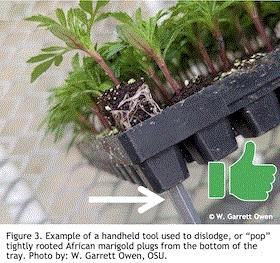What’s Happening Here?
This is a jam-packed newsletter, but I thought it would be fun to squeeze in a quick diagnostic challenge. I was recently asked to look at a few crops that were recently planted and set down inside a greenhouse:
Oenothera
Most of these plants look great. It may be difficult to see, but some of them look rough. Many plants aren't standing up and looking happy shortly after being planted. There’s also a slight hint of wilt symptoms on some of them. I even included a closeup thinking that might help.
Do you know “What’s happening here?” I’ll reveal the answer in a few minutes.
A Heated Conversation

I shared some information and commentary on the AHS Heat Zones in the last newsletter. An unusually large amount of feedback on this topic hit my inbox in the days that followed. Contrary to my subject line above, the feedback I received was all pleasant, appreciative and constructive. Out of respect for anonymity, I’ll withhold the names, but here are a few samples of the feedback I received.
“Our Florida home is in a community of over 1,100 homes, all of which the owners are from the North. After a lifetime of worrying about cold hardiness, all these people need to relearn gardening in a new environment. Sadly, there is not that much info out there.”
“I'm so happy that somebody brought this subject up. This is a challenge for perennial growers and breeders like us. It’s definitely a tricky subject.”
“As a transplant from the North, I never really concerned myself with the heat zones either. But as a transplant, I also see how consumers have a hard time finding plants that will survive in the South.”
“Thank you for sending out the article on heat zone maps. I agree there needs to be more information related to the heat zone map. The map and guidance may have changed as well. Also, I'm not sure if 86F degrees would be considered a heat day. I don't know how many times I have said in summer, “I'm glad this cold front came in and we are only getting up to 98F degrees today.”
“For many people, if they find a plant in big box store or in a catalog they figure they can plant it. They take the view that they have failed when it does not thrive or they believe the grower failed them. They give up on gardening or planting in general. That hurts our industry in all aspects.”
“Just because a plant is available for sale does not make it a good choice for survival.”
“I am glad this is being brought up, but there is probably a need to revisit this tool to help better define what region plants will be able to thrive in. I would be interested in a heat zone, but not sure how accurate it will be to our region (Texas) with the current criteria.”
“Thanks for the much-needed article on heat zones and appreciate you bringing this to the attention of the perennial world!”
As these few subscribers indicate, there's definitely an interest in including heat zone information in conjunction with cold hardiness information on care tags, cultivar descriptions and in catalogs. Thank you for your responses.

AHS Heat Zone Recap

|
The AHS Heat Zone map is divided into 12 zones. Each zone is identified by the average number of "Heat Days" or days above 86F it experiences in a year.
The zones are expressed with the highest heat zones listed first, followed by the lowest. For example, the heat zone rating for platycodon is AHS Heat Zone: 8 to 1.
|
|
AHS Heat Zone Average Number of
Days Above 86º F
|
|
Zone 1 |
0 Days |
|
Zone 2 |
1 to 7 Days |
|
Zone 3 |
8 to 14 Days |
|
Zone 4 |
15 to 30 Days |
|
Zone 5 |
31 to 45 Days |
|
Zone 6 |
46 to 60 Days |
|
Zone 7 |
61 to 90 Days |
|
Zone 8 |
91 to 120 Days |
|
Zone 9 |
121 to 150 Days |
|
Zone 10 |
151 to 180 Days |
|
Zone 11 |
181 to 210 Days |
|
Zone 12 |
>210 Days |
|
AHS Heat Zones for Perennials
I mentioned that if there was enough interest in the heat zones for various perennials that I would compile a listing using my perennial database I’ve added to over the years. Based on the comments I’ve shared above, I’d say there is absolutely an interest in heat zones for perennials.
Click the image above or click
HERE to download a full-sized PDF of the heat zones for over 200 perennials.
Here are my disclaimers and apologies: The information in the table above is at least 20 years old. It was collected from numerous sources, including catalogs (not specific trial publications and scientific results), therefore, there could be some discrepancies with the zones listed. The listings do not reflect any climate changes that may have occurred over time. These listings do not include specific cultivars and the heat tolerance of today’s cultivars could vary from those of the past. I compiled the table rather quickly and did not review any of the nomenclature (spelling or name changes).
Use this information only as a guideline and not as an absolute. For example, in the last issue, I mentioned platycodon has an AHS Heat Zone of 8 to 1, one of the respondents brought to my attention that it performs very well in northern Texas, which, according to the map, is a solid Heat Zone 9.

Heat Zone Book
|
None of the information from this book was included in the table above. It’s likely my information overlaps with the book, but there may be some differences and perennials that aren't included in the table above. It’s currently only $10.46 on Amazon.
|
 |
A Collective Effort
I even tried to search online for perennial heat zones to incorporate into the listing above, but surprisingly came up rather empty handed. I guess everything isn’t online afterall. It appears heat zones have fallen completely out of favor and not even the almighty Google can help.
It’s not clear to me why the AHS Heat Zones never became an industry standard like the USDA Cold Hardiness Zones have. Were the heat zones being confused with the cold hardiness zones, as both of them use similar numbers that often overlap with one another? Was there an inadequate number of trial sites in each “heat zone” to provide accurate zone ratings? Was it the cost of trialing perennials at numerous locations throughout the country? Unfortunately, I don’t have the answers to these questions. Do you have any insights you could share?
As individuals, it’s hard to understand the reasoning behind which industry concepts and practices become standards. Perhaps the value of heat zones was misunderstood at the time. Maybe it was an excellent idea, but it was ahead of its time. It seems there is value and interest in reinstating heat zones in product listings now.
The question is, “How do heat zones become relevant again?” Afterall, there's no governing body or horticultural organization that oversees or drives these practices. In this case, I imagine it would be a collective or collaborative effort. Each of us needs to play our part.
-
If you're a consumer, ask your garden center for heat zones and let them know it would be helpful.
-
If you purchase starter plants or finished containers, start having conversations with your suppliers, brokers and breeders to inform them of your interest and the value of using heat zones.
-
If you're a breeder, consider incorporating heat zones and temperature data into your trial protocols.
-
If you're a trial location review plant survival with high temperatures to determine heat zones for the perennials you're currently trialing, as well as those you've trialed in the past.
-
If you're a professional organization, ask your members if this is important and consider supporting heat zone research.
-
If you're a university, consider implementing heat zone trials into your trial protocols.
This is absolutely a collective effort. I can almost guarantee that the resurgence of heat zones will never happen if nobody brings it up. Each of us has to play a part. Just mentioning it once is not enough—be sure to keep mentioning it and work your way up the decision-maker ladder. I have no idea if the wide scale use of heat zones will ever return, but if it’s important to you, I encourage you to let your interest be heard.

The Answer is ...
Oenothera
I shared these images of oenothera with you at the top of the newsletter and asked if you knew why some of the plants looked less happy than others. I also mentioned that I was asked to look at a few crops. Here’s another crop showing similar symptoms:
Platycodon
Do you know what’s causing some plants to appear off while others look normal? If you answered the starting materials (plugs) were damaged at the time of planting, you earned yourself a gold crown.
The damage occurred to these plugs as they were being pulled out of the plug trays when they were being planted. The injury mostly occurred to the plants in cells that had the least amount of roots on them. They were essentially being ripped out of the growing mix, causing injury to the roots and/or plant stems, whereas the fully rooted cells came out of the trays intact and without injury.
Transplanting Plugs & Liners

Rem oving Plugs and Liners
oving Plugs and Liners
When removing plugs or liners from trays, gentle handling is paramount to preserve the integrity of the young plants. Use a dibble board, plug popper (Figure 2) or handheld tool (Figure 3) to loosen tightly rooted plugs from the bottom of the tray, as this minimizes root disturbance. Never pull plants out by their stems, as this can cause damage (Figure 4), potentially leading to plant death or severely stunted growth. If roots are torn during removal, the plant's ability to uptake water and nutrients is compromised, resulting in transplant shock and delayed establishment.
In severe cases, damaged roots can become entry points for soilborne pathogens, further jeopardizing plant health. Take care to remove plugs when the substrate moisture is at an optimal level—too dry and the root ball may crumble; too wet, and it may fall apart, exposing delicate roots.


My email is paul@opelgrowers.com if you have any comments, article suggestions or if you'd just like to say hello.
Best regards,

Paul Pilon
Editor-at-Large—Perennial Pulse
Director of Growing—Opel Growers
This email was received by you and 34,307 other fine subscribers!
If you're interested in advertising in Perennial Pulse, contact Kim Brown ASAP and she'll hook you up.